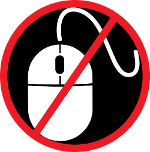What is it?
The #NoMouse Challenge is a global effort to raise awareness about accessible web design. Just follow these three simple steps:
Step 1. Use the Web without a mouse
If you or your organization has a website, try using it without a mouse. Use the keyboard instead. If you don't have a website, try a few of your favorite websites without a mouse, just using the keyboard. See below for Tips for using the keyboard to access web pages.
As you do this, ask the following questions:
- Can I access all features?
- Can I operate all buttons, sliders, and other controls?
- Can I easily tell where I am on the page?
Step 2. Learn more about accessible web design.
See the section below titled What is accessible web design?. If you're a person who designs or develops websites, creates videos, or produces digital documents, always consider whether the content you're producing is accessible to everyone. Try to learn and apply new skills that will help you to produce more accessible content.
Step 3. Spread the Word!
Use the #NoMouse hash tag wherever hash tags are supported.
Tips for using the keyboard to access web pages
- Press Tab to move to the next link, form element or button.
- Press Shift+Tab to move to the previous link, form element, or button.
- Press Enter or space bar to activate the current link or button.
- Use arrow keys, Escape, or other keys if doing so would seem to make sense.
- Some web and software applications include custom keyboard shortcuts. These can be helpful, but they require a lot of memorization and are sometimes difficult to find. Some applications include a link to "Accessibility" or "Keyboard shortcuts". For others, you may have to search the documentation.
What is accessible web design?
According to the World Health Organization, there are more than one billion people in the world who have some sort of disability, including nearly 200 million people who experience considerable difficulties in functioning. People with disabilities use a variety of tools and techniques for using the computer and accessing the Web. However, they're dependent on people who create digital content (e.g., websites, Word docs, PDFs, video, audio) to create these materials in ways that are accessible.
The methods for creating accessible digital content are well established and in many cases very simple. However, if people who produce digital content are unaware of these methods or choose not to apply them, people with disabilities are shut out, unable to access content and excluded from participating in our digital society.
Consider the following users and their needs related to accessing digital content:
- Some individuals with physical disabilities may be unable to use a mouse, and instead rely exclusively on their keyboard, or use assistive technologies such as speech recognition, head pointers, mouth sticks, or eye-gaze tracking systems. If a website is accessible only to mouse users, these individuals will be excluded.
- Individuals who are blind use audible output (products called screen readers that read web content using synthesized speech), or tactile output (a refreshable Braille device). If websites or digital documents are produced in ways that prevent assistive technologies from accessing their content, these individuals will be excluded.
- Individuals with cognitive or perceptual disabilities such as dyslexia may also use audible output and may benefit from changing the style of text (e.g., size, color, spacing). If websites or digital documents are delivered in ways that prevent users from using their custom tools and methods to read the document, these individuals will be excluded.
- Individuals with low vision may use screen magnification software that allows them to zoom into a portion of the visual screen, or they may have changed the default font size within their web browsers' preferences. If websites fall apart and become unreadable when enlarged, these individuals will be excluded.
- Individuals who are deaf or hard of hearing are unable to access audio content. If audio isn't transcribed or video isn't captioned, these individuals will be excluded.
How can I learn more?
The University of Washington Accessible Technology website includes a variety of helpful step-by-step guides on how to create accessible digital content, including:
- How to develop accessible websites
- How to create accessible documents
- How to create accessible videos.
Each of these resources includes helpful tips plus links to other resources for additional information.
